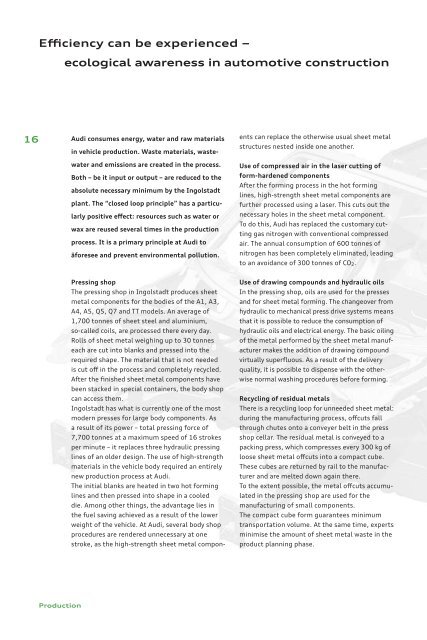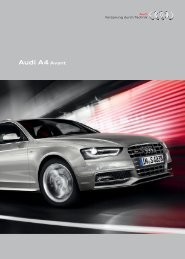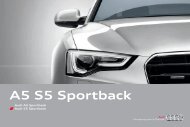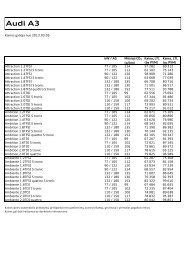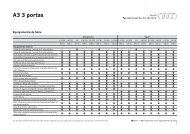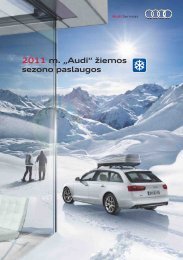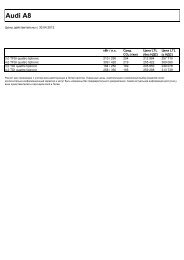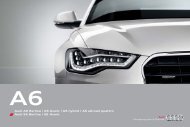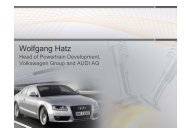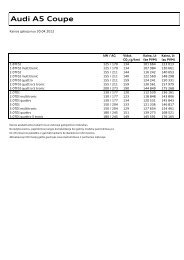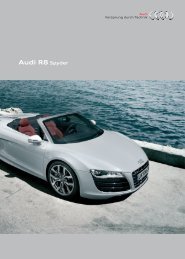Environmental Declaration 2010 for the Audi Plant in Ingolstadt
Environmental Declaration 2010 for the Audi Plant in Ingolstadt
Environmental Declaration 2010 for the Audi Plant in Ingolstadt
Create successful ePaper yourself
Turn your PDF publications into a flip-book with our unique Google optimized e-Paper software.
16<br />
Efficiency can be experienced –<br />
Production<br />
ecological awareness <strong>in</strong> automotive construction<br />
<strong>Audi</strong> consumes energy, water and raw materials<br />
<strong>in</strong> vehicle production. Waste materials, waste-<br />
water and emissions are created <strong>in</strong> <strong>the</strong> process.<br />
Both – be it <strong>in</strong>put or output – are reduced to <strong>the</strong><br />
absolute necessary m<strong>in</strong>imum by <strong>the</strong> <strong>Ingolstadt</strong><br />
plant. The “closed loop pr<strong>in</strong>ciple” has a particu-<br />
larly positive effect: resources such as water or<br />
wax are reused several times <strong>in</strong> <strong>the</strong> production<br />
process. It is a primary pr<strong>in</strong>ciple at <strong>Audi</strong> to<br />
ä<strong>for</strong>esee and prevent environmental pollution.<br />
Press<strong>in</strong>g shop<br />
The press<strong>in</strong>g shop <strong>in</strong> <strong>Ingolstadt</strong> produces sheet<br />
metal components <strong>for</strong> <strong>the</strong> bodies of <strong>the</strong> A1, A3,<br />
A4, A5, Q5, Q7 and TT models. An average of<br />
1,700 tonnes of sheet steel and alum<strong>in</strong>ium,<br />
so-called coils, are processed <strong>the</strong>re every day.<br />
Rolls of sheet metal weigh<strong>in</strong>g up to 30 tonnes<br />
each are cut <strong>in</strong>to blanks and pressed <strong>in</strong>to <strong>the</strong><br />
required shape. The material that is not needed<br />
is cut off <strong>in</strong> <strong>the</strong> process and completely recycled.<br />
After <strong>the</strong> f<strong>in</strong>ished sheet metal components have<br />
been stacked <strong>in</strong> special conta<strong>in</strong>ers, <strong>the</strong> body shop<br />
can access <strong>the</strong>m.<br />
<strong>Ingolstadt</strong> has what is currently one of <strong>the</strong> most<br />
modern presses <strong>for</strong> large body components. As<br />
a result of its power – total press<strong>in</strong>g <strong>for</strong>ce of<br />
7,700 tonnes at a maximum speed of 16 strokes<br />
per m<strong>in</strong>ute – it replaces three hydraulic press<strong>in</strong>g<br />
l<strong>in</strong>es of an older design. The use of high-strength<br />
materials <strong>in</strong> <strong>the</strong> vehicle body required an entirely<br />
new production process at <strong>Audi</strong>.<br />
The <strong>in</strong>itial blanks are heated <strong>in</strong> two hot <strong>for</strong>m<strong>in</strong>g<br />
l<strong>in</strong>es and <strong>the</strong>n pressed <strong>in</strong>to shape <strong>in</strong> a cooled<br />
die. Among o<strong>the</strong>r th<strong>in</strong>gs, <strong>the</strong> advantage lies <strong>in</strong><br />
<strong>the</strong> fuel sav<strong>in</strong>g achieved as a result of <strong>the</strong> lower<br />
weight of <strong>the</strong> vehicle. At <strong>Audi</strong>, several body shop<br />
procedures are rendered unnecessary at one<br />
stroke, as <strong>the</strong> high-strength sheet metal compon-<br />
ents can replace <strong>the</strong> o<strong>the</strong>rwise usual sheet metal<br />
structures nested <strong>in</strong>side one ano<strong>the</strong>r.<br />
Use of compressed air <strong>in</strong> <strong>the</strong> laser cutt<strong>in</strong>g of<br />
<strong>for</strong>m-hardened components<br />
After <strong>the</strong> <strong>for</strong>m<strong>in</strong>g process <strong>in</strong> <strong>the</strong> hot <strong>for</strong>m<strong>in</strong>g<br />
l<strong>in</strong>es, high-strength sheet metal components are<br />
fur<strong>the</strong>r processed us<strong>in</strong>g a laser. This cuts out <strong>the</strong><br />
necessary holes <strong>in</strong> <strong>the</strong> sheet metal component.<br />
To do this, <strong>Audi</strong> has replaced <strong>the</strong> customary cutt<strong>in</strong>g<br />
gas nitrogen with conventional compressed<br />
air. The annual consumption of 600 tonnes of<br />
nitrogen has been completely elim<strong>in</strong>ated, lead<strong>in</strong>g<br />
to an avoidance of 300 tonnes of CO2.<br />
Use of draw<strong>in</strong>g compounds and hydraulic oils<br />
In <strong>the</strong> press<strong>in</strong>g shop, oils are used <strong>for</strong> <strong>the</strong> presses<br />
and <strong>for</strong> sheet metal <strong>for</strong>m<strong>in</strong>g. The changeover from<br />
hydraulic to mechanical press drive systems means<br />
that it is possible to reduce <strong>the</strong> consumption of<br />
hydraulic oils and electrical energy. The basic oil<strong>in</strong>g<br />
of <strong>the</strong> metal per<strong>for</strong>med by <strong>the</strong> sheet metal manufacturer<br />
makes <strong>the</strong> addition of draw<strong>in</strong>g compound<br />
virtually superfluous. As a result of <strong>the</strong> delivery<br />
quality, it is possible to dispense with <strong>the</strong> o<strong>the</strong>rwise<br />
normal wash<strong>in</strong>g procedures be<strong>for</strong>e <strong>for</strong>m<strong>in</strong>g.<br />
Recycl<strong>in</strong>g of residual metals<br />
There is a recycl<strong>in</strong>g loop <strong>for</strong> unneeded sheet metal:<br />
dur<strong>in</strong>g <strong>the</strong> manufactur<strong>in</strong>g process, offcuts fall<br />
through chutes onto a conveyer belt <strong>in</strong> <strong>the</strong> press<br />
shop cellar. The residual metal is conveyed to a<br />
pack<strong>in</strong>g press, which compresses every 300 kg of<br />
loose sheet metal offcuts <strong>in</strong>to a compact cube.<br />
These cubes are returned by rail to <strong>the</strong> manufacturer<br />
and are melted down aga<strong>in</strong> <strong>the</strong>re.<br />
To <strong>the</strong> extent possible, <strong>the</strong> metal offcuts accumulated<br />
<strong>in</strong> <strong>the</strong> press<strong>in</strong>g shop are used <strong>for</strong> <strong>the</strong><br />
manufactur<strong>in</strong>g of small components.<br />
The compact cube <strong>for</strong>m guarantees m<strong>in</strong>imum<br />
transportation volume. At <strong>the</strong> same time, experts<br />
m<strong>in</strong>imise <strong>the</strong> amount of sheet metal waste <strong>in</strong> <strong>the</strong><br />
product plann<strong>in</strong>g phase.<br />
Innovative lightweight construction<br />
reduces fuel consumption.<br />
Shocks and vibrations<br />
Every meet<strong>in</strong>g of <strong>the</strong> two halves of <strong>the</strong> die,<br />
weigh<strong>in</strong>g up to 22 tonnes, causes noise and<br />
vibrations. The shocks and vibrations from up to<br />
500,000 strokes a day are virtually elim<strong>in</strong>ated<br />
by position<strong>in</strong>g <strong>the</strong> presses not directly onto <strong>the</strong><br />
concrete foundation but onto coil spr<strong>in</strong>gs, which<br />
absorb <strong>the</strong> vibrations to a large extent.<br />
Body shop<br />
Robots weld toge<strong>the</strong>r <strong>in</strong>dividual components of<br />
steel and alum<strong>in</strong>ium <strong>in</strong>to subassemblies to create<br />
a vehicle skeleton. Various jo<strong>in</strong>t<strong>in</strong>g techniques are<br />
used. Innovative spot-weld<strong>in</strong>g, laser-weld<strong>in</strong>g and<br />
adhesive techniques reduce <strong>the</strong> consumption of<br />
operat<strong>in</strong>g materials. The cleaner <strong>the</strong> weld<strong>in</strong>g<br />
electrodes of <strong>the</strong> robots, <strong>the</strong> lower <strong>the</strong> energy<br />
consumption. For that reason <strong>the</strong> electrodes are<br />
cleaned regularly. After <strong>the</strong> body has been<br />
assembled up to <strong>the</strong> passenger compartment, <strong>the</strong><br />
doors, bonnets, boots and tailgates are fitted.<br />
The types of pollution caused <strong>in</strong> <strong>the</strong> body shop<br />
<strong>in</strong>clude non-hardened adhesives, emissions of<br />
dust and harmful substances result<strong>in</strong>g from<br />
gr<strong>in</strong>d<strong>in</strong>g and weld<strong>in</strong>g procedures, as well as noise<br />
from production equipment and ventilation<br />
systems. High levels of efficiency and improved<br />
spot weld quality are achieved as a result of <strong>the</strong><br />
changeover from pneumatic weld<strong>in</strong>g tongs to<br />
electrically operated weld<strong>in</strong>g tongs. At <strong>the</strong> same<br />
time, ano<strong>the</strong>r positive effect is <strong>the</strong> reduction <strong>in</strong><br />
energy consumption, and hence <strong>in</strong> CO2 emissions.<br />
Pa<strong>in</strong>t shop<br />
Pa<strong>in</strong>t<strong>in</strong>g is <strong>the</strong> part of <strong>the</strong> process with <strong>the</strong> greatest<br />
environmental relevance. Solvent emissions<br />
have been drastically reduced s<strong>in</strong>ce <strong>the</strong> changeover<br />
to water-based pa<strong>in</strong>ts. All of <strong>the</strong> pa<strong>in</strong>ts used <strong>in</strong> <strong>Ingolstadt</strong><br />
are lead-free. The degree of automation<br />
is cont<strong>in</strong>ually be<strong>in</strong>g developed <strong>in</strong> order to m<strong>in</strong>imise<br />
spray losses when pa<strong>in</strong>t<strong>in</strong>g.<br />
This <strong>in</strong>cludes such processes as electrostatic<br />
application. Flush<strong>in</strong>g systems <strong>in</strong> <strong>the</strong> spray booths<br />
reduce <strong>the</strong> release of pa<strong>in</strong>t particles. The extracted<br />
air from <strong>the</strong> filler and clear lacquer dryers<br />
is taken to a <strong>the</strong>rmal post-combustion unit and<br />
<strong>the</strong> result<strong>in</strong>g heat is used aga<strong>in</strong> to heat <strong>the</strong> dryer.<br />
Closed water loops ensure a significant reduction<br />
<strong>in</strong> water consumption <strong>in</strong> <strong>the</strong> pa<strong>in</strong>t<strong>in</strong>g process.<br />
Phosphatis<strong>in</strong>g<br />
The surface of <strong>the</strong> body must be pre-treated at<br />
<strong>the</strong> start of <strong>the</strong> pa<strong>in</strong>t<strong>in</strong>g process. Phosphatis<strong>in</strong>g<br />
baths protect aga<strong>in</strong>st corrosion and result <strong>in</strong><br />
better adhesion of <strong>the</strong> pa<strong>in</strong>t.<br />
This process generates r<strong>in</strong>s<strong>in</strong>g water, which is<br />
polluted with nickel, manganese, z<strong>in</strong>c and<br />
zirconium. Us<strong>in</strong>g a split flow treatment method,<br />
it is possible to precipitate out a high proportion<br />
of <strong>the</strong>se heavy metals. As a result of this process,<br />
<strong>the</strong> legal limits <strong>for</strong> discharge <strong>in</strong>to <strong>the</strong> sewer<br />
system are met by a large marg<strong>in</strong>.<br />
Water: <strong>Audi</strong> has reduced <strong>the</strong> specific<br />
wastewater volume by 69 % <strong>in</strong> 20 years.<br />
17


